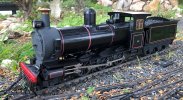A while ago I scratch built the South Australian Yx class loco shown in the photo. It uses a Bachmann 4-6-0 chassis which I modified to be a 2-6-0. It is battery radio controlled with the batteries in the boiler. From the start, the loco has always had a problem....it will pull next to nothing as a result of wheel slip. On straight level track, it will pull (only) two bogie coaches. As soon as the coaches enter an R5 curve or a 1 in 50 incline then the loco wheel slips to a halt. The loco is actually a 2-4-0 because the drivers are unsprung and the centre (flangeless) driver does not actually touch the track.
The loco (without tender) weighs 1.7Kg. Please can someone tell me the weight of a Bachmann Annie (or similar) 4-6-0 so that I can tell if my loco is just too light?
Thanks
Peter Lucas
MyLocoSound
The loco (without tender) weighs 1.7Kg. Please can someone tell me the weight of a Bachmann Annie (or similar) 4-6-0 so that I can tell if my loco is just too light?
Thanks
Peter Lucas
MyLocoSound

